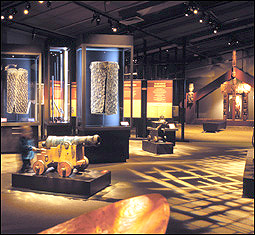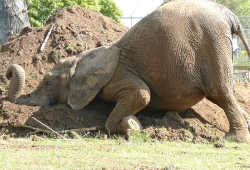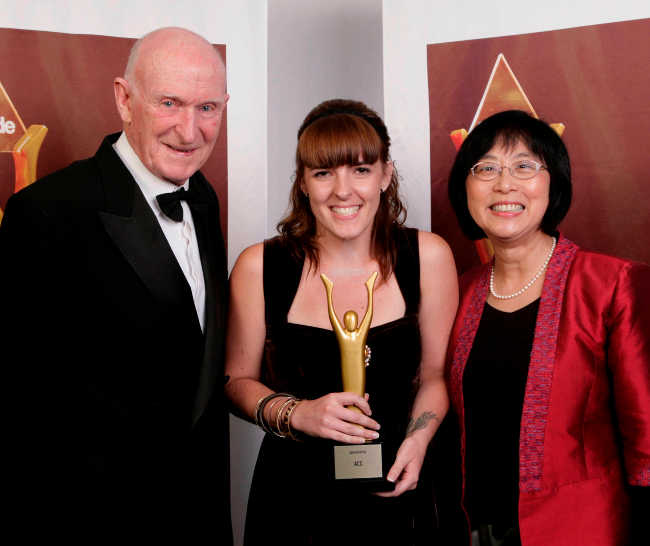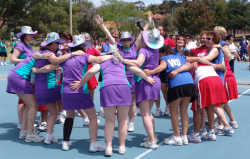Dorothy – 20/10/03
The site for Puke Ariki heightens its beauty and significance. The two winged building is situated in New Plymouth’s CBD, next to the Coastal Walkway and the Tasman Sea.
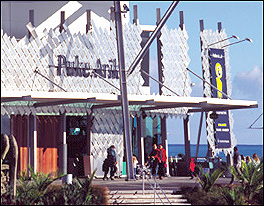 |
| Puke Ariki |
Over the years, the hill was used for land reclamation and by 1905 it had been demolished. In the late 1980s, the New Plymouth District Council recognised the potential for public use of the land and the concept of Puke Ariki was born. This was a momentous move for a city that had turned its back on the ocean. Today, Puke Ariki is once again the hub of the community, a meeting place of ideas, people and energy.
Eight iwi worked together This facility marks the first time that the eight iwi (Maori tribes) of Taranaki have worked together on a significant public project, and New Plymouth District Mayor, Peter Tennent, says it is an example of how well tangata whenua (the local people native to the area), local government and local businesses in the region can cooperate.
Puke Ariki offers a wide range of services, displays, information and experiences
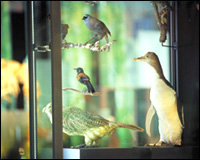 |
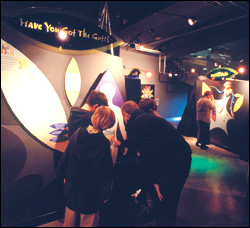 |
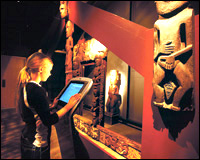 |
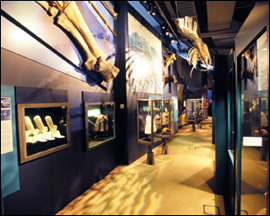 |
| Glimpses of Puke Ariki | |
The Maori Gallery The Maori Gallery is sited on the second level of the North Wing in Puke Ariki. It has purposely been built at the same level as the hill that was the Puke Ariki Pa. The first site to greet the visitors is a blend of contemporary and traditional aspects of a waharoa or Maori entrance to a kainga (village).
Next is the creation story of Rangi and Papa followed by taonga associated with the story. Among these is the famous dogskin cloak (huruhuru kuri). Close scrutiny of the cloak reveals the ears and tails in the fall of the cloak.
|
|
| Maori gallery |
The gallery follows a timeline of Taranaki Maori history from the arrival of the people from Hawaiki to the European immigrants and the fighting that followed, and on into the twentieth century.
The stories have all been researched and written by Taranaki Maori people.
The treasures include a waka (canoe) of unknown origin, a kotiate (whalebone weapon), a tokotoko (talking stick), a carved canoe prow, and a funeral cloak, all associated with Maori leaders. Visitors can read the stories of these taonga, clearly set out.
Taranaki Naturally This area offers an interactive experience which explores the visual geological
history of Taranaki in particular and also New Zealand as a whole. The well-known historian Ron Lambert, wrote the text for the area, and found it a challenge to make the text brief enough and to express the concepts involved in geology in plain English accessible to the visitors many of whom have little knowledge of geology.
Ron Lambert advises visitors to go first to the glass forest and then move anti- clockwise around the gallery. This takes viewers through the time when New Zealand was part of Gwondana, and shows the plants that flourished then and the animals. which are ancestors of the kiwi, tuatara, moa, weta and frogs. Displays also feature the formation of the Taranaki basin and the oil deposits, the mountains of the area and Paritutu and the Sugar Loaf Islands.
The final part of the circuit leads to the displays of contemporary flora and fauna.
Taranaki Life This area highlights the past and the present. Stories of the past include such topics as cocksfooting, once a major industry on Banks Peninsula and in Taranaki, and Charlie Maxwell who invented a hay bale loader. The land wars, the work of early settlers, industry, everyday life, immigration, farming and education are among other topics covered in the gallery. Sound, film clips, light, touch screen computers all expand the content and add to the interest of Taranaki Life.
Richmond Cottage To immerse yourself further in the atmosphere of Taranaki in the past visit Richmond Cottage and Heritage Garden which recreate a typical colonial home with a setting of garden and native bush. In the garden the settlers planted flowers, vegetables, fruit trees and herbs for medicinal use.
Taranaki Research Centre The archive collection formerly held by the library and the museum archive are now held together in the Taranaki Research Centre.
Taranaki Experience
Allow time to sit back and experience to the full the 12-minute multi-media cinema, Taranaki Experience as it whirls you through the province.
Temporary exhibitions gallery This offers another visual experience with changing international and New Zealand exhibitions.
Discover it! – an educational facility In the basement of the old library, Discover it! offers young people a wide range of displays and activities which are changed regularly to hold the interest of regular young visitors. These include books, specimens of minerals, fossils and machinery, a virtual forest linked to video information, music videos, a virtual container crane to load ships at the port, and a virtual dress-up wardrobe which shows on a screen the visitor wearing the chosen garments.
New Plymouth’s Visitor Information Centre In keeping with the concept of many facilities under one roof the New Plymouth Visitor Information Centre is now also sited in Puke Ariki. Here you can make bookings for travel, accommodation and activities.
Vivid, the retail centre This is close to the Information Centre and stocks Puke Ariki products, good quality souvenirs and books.
The Daily News – a cafe and a news centre Coffee and a range of foods will be served at the Daily News Cafe as you explore the newspapers and magazines. Clocks in the cafe will show times in different cities around the world. On one wall are three television screens, one showing BBC news, another showing CNN news and a third with a rotation of pictures which have recently appeared in The Daily News.
Arborio Restaurant This restaurant offers casual dining with a cosmopolitan menu and extensive wine list. The restaurant is on the ground floor of Puke Ariki on the sea-side of the Taranaki Foyer. It is open seven days a week from 9am until late. Diners are able to sit outside all year round on the balcony, because a permanent structure screens diners and gas lamps will provide warmth. As they enjoy their meal diners will be able to see the sea and hear the surf and watch the Wind Wand beside the Coastal Walkway.
This is a family restaurant and children will be given fun pages and pencils to take home.
Space problems solved by the new facility The New Plymouth Library and the Taranaki Museum had been in shared premises since 1865 – first in a building near their current site (the Carnegie Building), then in the War Memorial Building (from 1960). Local government in New Plymouth had looked at options for relieving the severe space restrictions in both facilities since 1973.
The construction involved retrofitting the War Memorial Building (South Wing) and linking it via an airbridge with a new building on Puke Ariki Landing (North Wing).
The move to Puke Ariki has increased display space from about 78 square metres in the old Taranaki Museum to 3200 square metres and there is a greater area available for storing taonga and other precious objects. The library too is larger and extends over four floors of the building.
Puke Ariki awards
Puke Ariki won Creative New Zealand’s prestigious Creative Places Award for 2003. It was also the winner of the Strategic Arts Initiative category.
The prize for the Premier Places Award is a commissioning grant from Creative New Zealand for a public artwork, to be chosen by the New Plymouth District Council.
For its Strategic Arts Initiatives category win, Puke Ariki won a specially commissioned ceramic box made by leading New Zealand ceramic artist Merilyn Wiseman and a certificate.
The Creative Places Award was established by Creative New Zealand in 1999 to recognise innovative, local authority arts initiatives and their significant contribution to the social, economic, environmental and cultural wellbeing of communities. Entries are judged by an independent panel of judges, with both arts and local authority expertise.
Be sure to include Puke Ariki on your itinerary Clearly repeat visits to Puke Ariki would be enriching, but if your itinerary allows you only a short time, it is still worth visiting the complex to gain some comprehension of the range of displays and facilities and explore what attracts you most.

